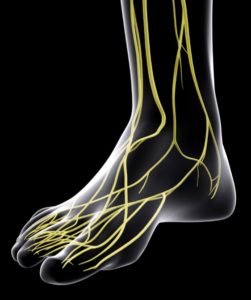“The good news about PAD is that there’s hope. There is treatment and it’s excellent.”
“Blood brings oxygen and nutrients to your feet and toes, which they need to stay healthy,” explained Rainwater. Without proper blood supply, nerves and muscles are affected. The body reacts in the form of pain or leg cramps, signaling that medical attention is needed. Rainwater continued, “If you’re a nerve cell and you don’t get oxygen or nutrients or vitamins, how are you going to function?” The blood vessels carry those nutrients into your tissues for your nerves to use and if you don’t have good circulation your nerves can’t function normally. “How do your nerves tell you what’s wrong? They start to itch, they might start burning, they might become numb, or they might have sharp, shooting electric style pain. That’s your nerve crying out for help. PAD is a serious condition that can’t be ignored.”
It’s often overlooked because people believe that it’s a sign of aging when they can no longer tolerate walking because of pain or cramping in one or both of their legs, or they have a burning or aching pain in their feet and toes while they’re resting or lying in bed. “It’s not normal to lose mobility over time, it’s not normal for a patient to have constant leg pain, to not be able to walk from their house to the mailbox and back,” said Rainwater. “PAD is often felt in the legs or feet first. Patients notice burning, tingling, cramping or wounds that won’t heal.” Sometimes symptoms are called neuropathy, but in many cases they’re being caused or being made worse by PAD. These changes to everyday living could be signs of poor circulation and shouldn’t be dismissed as part normal aging.
“PAD is one of those conditions that’s sneaky,” continued Rainwater. “The most notorious aspect of this disease is that it creeps up on patients and makes them believe that it’s normal, that it’s typical, and that they’re going to have to suffer this for the rest of their lives.” He urges people to talk with their doctor about any changes they notice in their feet or legs. “The earlier the condition is identified, the better your opportunity for preventing it from getting worse.” Lifestyle changes, medication and treatment can help prevent PAD from progressing to dangerous consequences.
“The good news about PAD is that there’s hope. There is treatment and it’s excellent.” A minimally invasive procedure is done in an office setting and patients are home within hours and back to everyday activities with almost no downtime, no stitches and no overnight hospital stay. Medicare as well as most insurance plans will cover treatment.
“So what we do,” said Rainwater, “is go into the bloodstream to find the blockage with imaging guidance. Then we remove the blockage with small tools that can go into the smallest arteries, and we remove the blockage and restore that blood flow without surgery, without scalpels, without stitches.”
Through the past 20 years, diagnosis and treatment have advanced. The biggest benefits are how easy it is for the patient and the difference it makes in their lives. “One of the most gratifying things that I experience in my job is seeing patients, sometimes even in recovery, feel their foot for the first time in years,” said Rainwater. “When they come back for their follow up visit, that’s when we really get to talk about how much better their life is and how much more hopeful they are. They start making plans again, they start thinking about vacations again, and how they are going to be able to do the things that they used to do in their lives.” FBN
By Reisha Zang
Dr. Joel Rainwater, M.D., is an interventional radiologist who uses imaging technology and techniques to care for medical conditions that affect the nearly every organ system in the body. These conditions include PAD, Enlarged Prostates, Liver Cancer, PVD, Compression Fractures, and Uterine Fibroids. He can be reached at Comprehensive Integrated Care, 928-719-7400.
Reisha Zang is director of communication at CiC. You may contact her at 928-719-7400 or reisha.zang@ciccenters.com.





